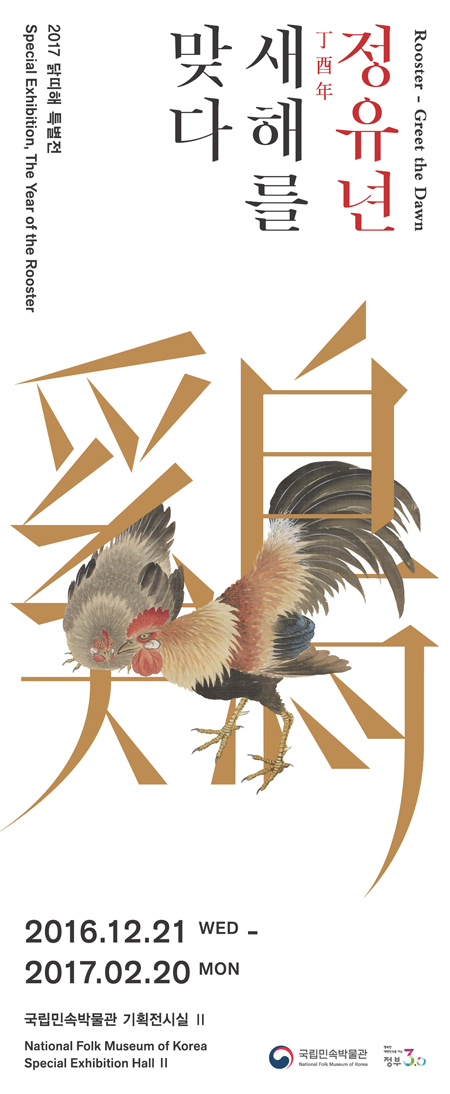Introduction
Rooster’s crow heralds the breaking of dawn signaling the beginning of a new day. The rooster has been a good friend of humans as a time-teller ever since man began to work when the sun rises and rested when the sun goes down.
In welcoming the New Year of the Rooster, National Folk Museum of Korea presents Rooster – Greeting the Dawn. The special exhibition features the rooster, a familiar animal companion, and its ecological and cultural significances under three themes – “Guardian of the West,” “Animal of Five Virtues,” and “Companion of Everyday Life.”
It is hoped that this exhibition will provide visitors with an opportunity to explore and discover the cultural symbols and significances associated with the rooster. We invite you to usher in the New Year with the powerful crow of the rooster.
Prologue
“Cock-a-doodle-doo”
A familiar call that breaks the silence of the darkness,
A sound that announces daybreak,
heralding the New Year, full of hope.
Part I: Guardian of the West
The Rooster occupies the tenth position in the twelve zodiac animal deities, a cycle of twelve animals representing hours of the day and directions. In terms of direction, the rooster corresponds to the West, and between 5 to 7 p.m. in terms of hours.
In Korea, during the Silla Kingdom, the concept of the zodiac was integrated with Buddhist religious culture, and twelve zodiac animal deities appeared on lower parts of stupas or the exterior of tombs as guardian deities of direction, carved as sculptural figures or carved in relief on stone slabs.
In the main throne hall (Geunjeongjeon) of Gyeongbokgung, the royal palace of the Joseon dynasty, the two-tiered stone terrace (Woldae) is surrounded by a stone railing carved with figures of the twelve zodiac animal deities arranged in each relevant direction. Representations of the twelve figures are also featured on implements displaying direction including the compass and geomantic compass (Yundo) as well as the device displaying time, the hemispherical sundial called Angbuilgu.
Part II: Animal of Five Virtues
The Rooster, which is a domestic animal, is considered to be an embodiment of the five virtues. In his book Chukgyeseol (畜鷄說), Ha Dal-hong (1809-1877) of the late-Joseon period alluded to a historical event recorded in Hanshi waizhuan (漢詩外傳, Han Ying's Illustrations of the Didactic Application of the Classic of Songs) to explain the significance of the five virtues — “wisdom” (mun, 文) shown by the crown or comb on its head; “valor” (武, Kr. mu,) demonstrated by its spurs; “courage” (勇, Kr. yong,) to fight against enemies; “benevolence” (仁, Kr. in) extended by sharing food with others; and “reliability” (信, sin) revealed by the crowing every day at the same time with unchanging regularity.
In this way, people believed that the rooster is an animal embodying the five virtues and therefore worth emulating, and they depicted roosters on various everyday objects including artworks.
Part III: Companion of Everyday Life
The Rooster is regarded as an animal sharing an intimate relationship with humans and embodying diverse symbolisms that are revealed in our history and everyday life. It is also perceived as an auspicious animal that wards off evil spirits, and paintings to celebrate the New Year featuring depictions of roosters were often pasted in front of closets or doors. Following the opening of ports in the Joseon Dynasty, foreigners appropriated illustrations of roosters on the covers of books introducing Korea.
Roosters have been of vital importance in our daily lives, and their motifs have often been featured on everyday objects as roosters are regarded as symbols of diligence and family affection.
Epilogue
Peaceful landscape of hens and chicks playing in the courtyard
In this New Year of the Rooster, we wish for peace, love, and harmony in your home and all the best on your endeavors.



